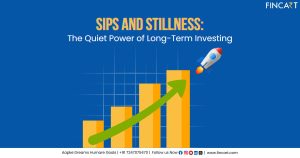When it comes to affordable ways of saving and investing, two options that come to mind are Systematic Investment Plans (SIPs) and Recurring Deposits (RDs). These two options share a couple of similarities. First, you don’t need a large amount of money to get started with either, and second, both require regular contributions over a period of time.
If you’re looking to create wealth through these options and are having trouble choosing between the two, understanding the SIP and RD Difference will help you make an informed decision. So let’s dive right into SIP vs RD and compare their advantages and disadvantages to see which option would align best with your financial goals.
Difference Between SIP and RD
| Factor | Systematic Investment Plans | Recurring Deposits |
| Description | An SIP is a way to invest in mutual funds. You contribute a fixed amount at regular intervals like quarterly or monthly. | With RD, you contribute a fixed amount every month into a savings account for a predetermined period. |
| Returns | Mutual fund returns are market-linked and they vary from one type of fund to another based on the investment strategy and asset allocation. | RD offers a guaranteed interest rate on your deposits. |
| Nature of Returns | SIP returns are market-linked. | RD returns are fixed. |
| Type of Investment | SIPs offer a variety of investment options which allow you to invest in different types of mutual funds such as equity, debt, or hybrid funds. | RDs are fixed-income products, so they do not offer a range of investment types but provide a consistent return on the deposited amount. |
| Tenure | No specific tenure is associated with SIPs. You can invest for as long as you like, whether it’s a few months or several years. However, some mutual funds do have a tenure or lock-in period such as closed-ended funds and ELSS. | RDs allow investors to stay invested from 6 months to 10 years. Premature withdrawal can attract a penalty. |
| Risk | SIP risks depend on the category of mutual fund you’re investing in. For example, equity mutual funds come with high risks whereas liquid funds have lower risks as they invest in fixed-income securities. | The risk associated with RDs is very low due to guaranteed returns. |
| Liquidity | Different mutual funds have different terms. For example, close-ended funds have limited liquidity. Most funds, however, have high liquidity and allow you to quickly redeem your units without any exit load. | Compared to SIPs, RDs offer low liquidity. Investors looking to withdraw money prematurely have to pay a charge. |
| Taxation | Income earned from SIPs is classified as capital gains. Based on the type of fund and the duration they were held, LTCG and STCG are charged. Some funds, such as ELSS allow you to claim a maximum of Rs. 1.5 lakh deduction under Section 80C. | RDs don’t allow investors to claim any tax exemptions or deductions. Earnings are added to your taxable income and are taxed as per your tax slab rate. |
| Suitable For | Due to the variety of mutual funds available, SIPs are suitable for investors with diverse financial goals and risk tolerances. | RDs are safe products suitable for conservative investors looking to earn steady and modest returns to preserve their capital. |
| Offered By | Mutual fund SIPs are offered by Asset Management Companies (AMCs). | Banks and post offices offer RDs. |
| Flexibility | SIPs offer incredible flexibility. They allow investors to alter their contribution amount as well as the frequency of investment, which means you can adjust your investment based on changes in your financial situation or market conditions. | RDs, on the other hand, are not as flexible. Once you set up an RD, the contribution amount and frequency are fixed for the duration of the deposit. |
Which is a Better Systematic Investment Plan or Recurring Deposit?
As you can see from the table above, both these options appeal to different types of investors. Hence one cannot say which investment option is better than the other outright – rather the choice depends on which option aligns best with an investor’s financial goals, risk tolerance, and investment horizon.
Recurring deposits offer guaranteed returns and are a safe choice for conservative investors looking for an option which is unaffected by market conditions. On the other hand, investors who want to grow their wealth by earning higher returns and are willing to accept market risks would benefit from investing in mutual funds through SIPs.
For example, an equity SIP can effectively help investors achieve long-term goals such as building a retirement fund or children’s education fund. Similarly, a recurring deposit can be used to preserve capital for short- to long-term goals such as saving for a car down payment or planning a family vacation. But it’s important to note that conservative investors are not stuck with just RD. They can also invest in lower-risk mutual funds like debt funds or liquid funds, which offer higher returns than RDs.
RD vs SIP: Which is Right for You?
The choice between RD and SIP depends on your financial goals and risk tolerance. If you are a conservative investor looking for guaranteed returns with minimal risk, recurring deposits would suit you more. You won’t have to worry about market fluctuations either. However, that doesn’t mean RD is the only option for conservative investors.
The variety of mutual funds available in the market includes options suitable for lower risk profiles, such as debt mutual funds and liquid funds, which offer more stability compared to equity funds while still giving you a chance to earn higher returns than RDs. These debt funds are not completely free of risk, but they have lower volatility and can be a good compromise between safety and growth.
On the other hand, if you are someone looking to grow your wealth through exposure to equity, SIPs would be more suitable. Aggressive investors can invest in equity-related mutual funds to very high returns. Over the long term, the risks associated with equity tend to reduce due to the market recovery and growth, as the impact of short-term volatility lessens. SIPs are also beneficial for investors with moderate risk tolerance.
Investments in hybrid funds such as balanced advantage funds can give you the double benefit of equity exposure and stability. On top of that, if you’re looking to save more taxes, an SIP in ELSS can help you reduce your taxable income by Rs. 1.5 lakh every year.
To make the best decision, you should consider consulting with a financial advisor. Financial advisors can assess your financial situation, goals, and risk tolerance and guide you in selecting the investment option that aligns with your needs.
If you decide to start an SIP, your advisor can help you choose the right mutual fund, advise you on how much you should invest, and make a strategy to help you meet your long-term financial goals. They can also monitor your mutual fund investment progress and make adjustments as needed to make sure you stay on track.
Advantages of SIP and RD
Advantages of SIP
- One of the biggest advantages of SIP is diversification. Mutual funds invest in a variety of assets such as stocks, bonds, and fixed-income securities across different industries like tech and pharma. This reduces the chances of a big loss because the performance of a single asset or sector has a smaller impact on the overall fund portfolio.
- The second most important benefit of SIPs is rupee cost averaging. Many investors play the dangerous game of timing the market by trying to buy low and sell high. This can be risky and often leads to missed opportunities. With SIP, the contribution is made every month regardless of market conditions. This means that you buy more units when NAV prices are low and fewer units when prices are high. Over time, this averaging effect reduces the impact of market volatility and lowers the average cost of your investments.
- Financial discipline is an essential skill for long-term success. SIPs help instil discipline as they require you to contribute regularly.
- SIPs are flexible as investors can decide how much they want to invest and how frequently. For example, if you get a promotion or a bonus, you can increase your SIP contribution amount and accelerate your investment growth. If you run into a financial setback, you also have the option to reduce or even temporarily pause your contributions without affecting your overall investment strategy.
- One can find a wide range of mutual fund schemes that are suited to investors of varying risk tolerances and preferences, so SIPs offer variety.
- SIP in ELSS can help investors reduce their tax liability under Section 80C.
Advantages of RD
- The greatest advantage of RDs is the assurance of returns. They offer a fixed interest rate which is generally on par with the rates offered on fixed deposits.
- Because recurring deposits are backed by banks and the post office and their returns are not linked with the market, they offer investors an option to earn a fixed, predictable return with minimal risk.
- They are an affordable option for investors looking to preserve the value of their capital.
- Like SIP, RDs also require fixed and regular contributions so they also cultivate a habit of disciplined savings.
- There is uncertainty about how much one will earn through SIPs as returns are unpredictable. With RDs, you know exactly how much you will earn when the term is up.
Disadvantages of SIP and RD
Disadvantages of SIP
- Mutual funds are subject to market risks, which can make returns unpredictable. These risks are not as high in debt or balanced funds but can be significant in equity funds due to their exposure to stock market fluctuations. That’s why equity funds should be given time to ride out short-term fluctuations and benefit from long-term market growth.
- Returns also fluctuate. One year they may be high, while in another year, they may not be as strong.
- There are certain types of expenses associated with mutual funds such as expense ratios and exit fees. Considering their impact is important as they can lower your gains.
Disadvantages of RD
- The monthly contribution amount is fixed, so RDs don’t give you the flexibility to change the amount should your financial situation change.
- If the RD interest rate offered by your bank changes at a later time, you won’t be able to benefit from the new rate for your existing RD. The interest rate you locked in when you started the RD will stay fixed for the entire tenure of that specific deposit.
- The returns offered by RD are also not very high compared to other investment options like mutual funds. This makes RDs less effective for wealth accumulation.
- You may be charged a fine if you decide to withdraw prematurely, so there are some liquidity concerns associated with RDs.
- There are no tax benefits of investing in RDs.
Secure your legacy for future generations!
Consult with Fincart to ensure your wealth is preserved and transferred according to your wishes. .
Conclusion
Both SIPs and RDs have their own pros and cons. While RDs give you a safe and predictable way to save, SIPs give you a chance to earn higher returns through disciplined long-term investing. There is no clear-cut winner between the two as both products are suitable for different types of investors. RDs cater to conservative investors looking for guaranteed returns not linked to the market, and SIPs are suited to a wide range of investors who are willing to take on market risks to earn higher returns.
If you decide that SIPs are the way to go, remember to carefully analyse and select the mutual fund that aligns with your financial goals and risk tolerance. To do so, consider factors such as the fund’s performance over the last 5 or 10 years, the fund manager’s track record, the underlying assets in the portfolio, risk-adjusted ratios, and the fund’s expense ratio. Compare these factors across multiple funds to select the ones that offer you the best balance of risk and return for your needs.
It’s always a good idea to consult a financial advisor before making any final decision, as they can give you unbiased and personalised advice that takes into account your financial situation, long-term goals, and risk appetite.




